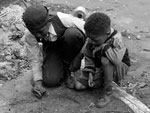BROWSE BY CATEGORY
- Archives and Libraries
- Blogs and Networking
- Bookmark This
- Digital Tools
- Examples of Teaching
- Exhibits
- Film Reviews
- History and Headlines
- Historic Sites and Museums
- Historical Thinking
- Holidays and Heritage
- Issues and Research
- Lesson Plans
- Material and Visual Culture
- Multimedia
- Organizations and Agencies
- Primary Sources
- Professional Development
- Publications
- Student Activities
- Teaching Materials
- Websites
History Hitting Home: Children's History, Local History, and Digital Storytelling

How do you connect history to students' own lives? Do you introduce them to the lives of children in the past? Explore local history with them? Let them recount history themselves using digital storytelling tools? Try combining two of these techniques—or all three—to give your students a sense of ownership over history.
Often, textbooks skim over or omit the stories of young people in the past. How did they live? What did they wear and eat? How did they play? What kind of work did they do? How did they learn? Seek out primary and secondary sources that explore the rich details of children's lives in the past. Some websites focus on children's history. Try:
- Children's Lives at Colonial London Town — the lives of three different families in colonial Maryland
- Children in Urban America — more than 4,000 primary sources from 1850 to 2000
- Laura Jernegan: Girl on a Whaleship — the full diary of a six-year-old who went on a four-year sea journey with her family
- Children and Youth in History — puts childhood in a global context with teaching modules, case studies, and more
- Little Cowpuncher: Rural School Newspaper of Southern Arizona — issues of a school newspaper written by K-8 southern Arizona students from 1932 to 1943
(Choose topic "Children" and search our Website Reviews for more. Search "Children" in our general search to find resources like Beyond the Textbook primary sources on girls' lives in the Progressive era.)
Textbooks also omit local history. Where did children play, learn, and work in the past in your area? How might you and your students connect with that past? Teachinghistory.org's Daisy Martin suggests trying local museums, historic sites, and libraries. High school teacher Roseanne Lichatin has had good luck connecting students with volunteer opportunities at local history museums.
But what about digital media and tools? How can you combine those with children's and local history? With the help of a still or video camera and digital storytelling tools, your students can recreate stories from your local past. For inspiration, check out our feature on the Of the Student, By the Student, For the Student project, a program of The Journey Through Hallowed Ground partnership. In this program, students visit local historic sites and write and film their own short documentaries or historical films "on location."
Remember that once students create materials such as these documentaries, you can use them, with students' permission, as teaching tools for future classes. Students often respond with enthusiasm to learning from and teaching their peers! The Journey Through Hallowed Ground's new lesson plans demonstrate ways to teach using student films. High school teacher James A. Percoco also taps into this energy by having his students guide the class around historic sites, and Elizabeth Glynn has her 11th-grade students create tours incorporating local monuments.
